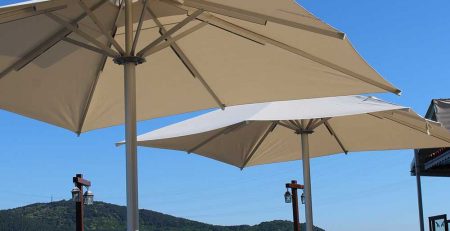Garden Umbrella Guide
Everything You Need to Know About Choosing a Garden Umbrella
Hello, you have decided to buy a patio umbrella for your home, villa, balcony, or terrace. However, which model, shape, or fabric should you choose? Choosing the right outdoor parasol can be really difficult. There are many factors that should be considered depending on your home, environment, budget, and preferences. This guide will help you gain a better idea of garden parasol, their styles, materials, and features. The matters specified in this guide will help you to eliminate the uncertainties during your purchasing decision and will allow you to rest outdoors for a long time. You will find the answers to all of your questions regarding our patio umbrella guide page, which we have prepared in order to answer all your questions.
Garden Umbrella Term by Country
Different countries have different names for outdoor umbrellas that we commonly refer to as “garden umbrellas” in Turkey. In the US, they are called “outdoor umbrellas” or “patio umbrellas”. In the UK, “garden parasol” and “outdoor parasol” are commonly used terms. Germany has “gartenschirm” and “terrassenschirm”, while France uses “parasol de jardin” and “parasol terrasse”. In Italy, they are known as “ombrellone da giardino” and “ombrellone terrazzo”, while Spain has “sombrilla de jardín” and “sombrilla de terraza”.
The Netherlands uses “tuinparasol” and “terrasparasol”, and in Australia, Canada, and New Zealand, “outdoor umbrella” and “patio umbrella” are commonly used. Brazil has “guarda-sol” and “ombrelone”, while in Japan, they use “アウトドアパラソル” (outdoor parasol) and in China “户外遮阳伞” (outdoor parasol). South Korea calls them “야외 우산” (outdoor umbrella) and in India, “बाहरी छतरी” (outdoor umbrella). Finally, Russia has “садовый зонтик” (garden umbrella).
As you can see, there are many different names for the same type of product, depending on the country you’re in. However, regardless of what they’re called, these outdoor umbrellas serve the same purpose: to provide shade and protection from the sun while you enjoy your time outside.
Best Patio Umbrella
It would be useful to start our guide with the “best patio umbrella” section. There are many criteria to be considered while buying a garden parasol. Even if these criteria change according to needs, the first criterion is the place where the patio umbrella will be used. The modern architectural design of the space to be used provides an uninterrupted transition from interior to exterior. Terraces or gardens with luxury outdoor furniture allow you to enjoy the nature without sacrificing style or comfort. Umbrellas to be used in spring and summer should be suitable for outdoor or poolside use. You will need a wider shade area to keep your family and guests cool and protected from the sun. Depending on all these areas and purposes of use, patio umbrellas are more economical and robust solutions than fixed ones.
Which Type of Outdoor Parasol Is the Right Choice for You?
The first decision you need to make when buying a garden parasol is its style. Your limitations in the space where the umbrella will be placed, your furniture arrangement, and expected use of the umbrella can determine which style is right for you. Even after considering all these variables, the main determining factor is your own personal pleasure. So, what are the options? There is a wide variety of patio umbrella models to choose from, however, they all fall into one of two categories: mid-pole or cantilever umbrellas. Now, let’s explain these models one by one.
Mid-pole Umbrellas
The defining feature of mid-pole umbrellas is the presence of a straight pole extending from the top of the umbrella to the surface. This pole can be a single-piece, or in some models, it can consist of two separate pieces that are joined together. It is important to note that mid-pole umbrellas can be fixed with a movable or a fixed base. This is the most common style of patio umbrellas, and umbrellas have been produced in this way for many years. This type of patio umbrella can be an effective protection against direct sunlight, however, exposure to ultraviolet radiation reflected or scattered from the sides reduces its overall capability of shade protection. Mid-pole umbrellas are divided into different categories according to their areas of use. You can assess our mid-pole umbrella models.
Market Umbrella
The most common produced and used in the mid-pole umbrellas are the models that are also called as market, grocery store, or Algida umbrellas. These umbrellas usually have a round and an octagonal shape. These umbrellas, which you can often see in front of the places such as markets, grocery stores, and greengrocers, are the choice of enterprises that want to protect their products, especially from the summer’s heat. Although market umbrellas are economical, they are weak and non-persistent due to the instability of the fabrics used and the umbrella arms consisting of wires. Their mean diameter is about 1,5-2 mt.
Semi-Umbrella
These umbrellas are not actually preferred in our country. The reason is that instead of such umbrellas, different shading systems such as bendy tents are generally preferred. These umbrellas need to be mounted on a wall for installation and use. Balcony edges are the most preferred areas.
Materials Used in Garden Parasol
Selection of the materials for your umbrella is really all about deciding your priorities. Do you try to match your umbrella with the look of your outdoor furniture set? Are you worried about the durability of the place to be used due to the factors such as humidity and wind? Or do you want to complete the landscape and architectural design of your home? It is possible to find garden parasol manufactured with different materials and colorful fabrics, modern or classical, for all of your criteria. The materials used in the poles and arms of garden parasol are generally of 3 different types. Aluminum, wooden, and plastic. Are you worried about durability in a humid or windy environment? Or do you really want to complete the landscape and architectural design of your home? Each material has its own advantages and characteristics, so you first need to decide which one suits your needs the best.
Wooden Parasol
Wooden parasol has a classic and timeless attraction. Their natural, sophisticated appearances are useful in green environments where nature is at the forefront. A well-maintained wooden parasol adds a nice atmosphere when used in rich wood-covered furniture and parquet areas. The trees most commonly used for these umbrellas are teak, eucalyptus, and bamboo. However, these high-cost raw materials and maintenance make wooden parasol very expensive.
Wood is treated to be resistant to insects, rotting, and the weather conditions, however, it tends to fade after prolonged exposure to sun and rain. In addition, wooden poles are less durable than their aluminum and plastic counterparts and can break in case of heavy winds. If you are going to prefer a garden parasol with a wooden appearance, we recommend you choose aluminum umbrellas that are painted in wood color.
Plastic Umbrella
Patio umbrellas with plastic poles and arms are not preferred to be produced in our country. These plastic and fiberglass umbrellas are actually among the most durable products. Fiberglass is lightweight, tough, and much more flexible than wood or aluminum. Thus, this is the main reason for durability in the umbrellas. This flexibility allows it to bend without breaking, even in the most severe storms. In addition, fiberglass plastic will not rust or rot, thus, it shows a good performance even under wet and humid ambient conditions.
As it tends to be more expensive than other materials, its ability to withstand against harsh weather conditions for years makes it a strong product in the long run. Plastic patio umbrellas can be prepared in many colors like aluminum umbrellas. Many modern garden parasol use aluminum and plastic materials together by taking the advantage of both materials. While aluminum is preferred for the mid-poles or side-poles, plastic parts are preferred at the places requiring flexibility such as umbrella fasteners.
What should be the Size and Shape of a Patio Umbrella?
After deciding on the outdoor parasol material and style, the next step is to decide on the shape and size of the umbrella. The area where large garden parasol will be used should be strong against bad weather conditions. However, it can deteriorate the ambiance of your terrace, garden, or pool area. Your environment may also have some physical limitations such as overhanging branches, eaves, or walls. For such and similar reasons, the shape and size of the umbrella is an important criterion when purchasing a garden parasol.
Shape of the Garden Parasol
There are 3 options for the shape of the garden parasol to be preferred. They are square, round, and rectangular. The shape to be preferred among these 3 shapes is determined by the criteria such as the area and the shape or area of the table to be covered from sun light. Apart from these, the final criteria is, of course, your personal pleasure.
Round Patio Umbrella
If the area of the table or lounge chair to be shaded is symmetrical, a round (octagonal or hexagonal) umbrella will be the right choice for you. While round umbrellas provide a natural feeling that helps to create an intimate atmosphere, it also complements the traditional design styles. If you have a lot of leaves around, round eaves can reduce the need to prune the surrounding branches.
 Square Patio Umbrella
Square Patio Umbrella
Square umbrellas are another choice for symmetrical spaces by providing maximum shade for the area. They tend to enhance modern decoration styles and also create a stylish and elegant look. Square umbrellas provide a sense of visual balance when combined with the parallel architectural features of your terrace or garden. Square umbrellas can be used by combining side by side when compared to round umbrellas.
 Rectangular Garden Parasol
Rectangular Garden Parasol
Oval or longer tables are mostly adapted with rectangular umbrellas. A square or rectangular umbrella can cover the entire length of a long table. Rectangular umbrellas can be used to cover very large areas by using more than one umbrella side by side like square umbrellas.
Selection of the Umbrella Fabric
Regarding the selection of a garden parasol, the type of fabric to be used is an important factor rather than the color of the fabric. Thus, fabric selection is one of the most important decisions to be made when purchasing a garden parasol. Your umbrella is important not only with its color or pattern, but also being a product that protects you from the sun’s heat and direct sunlight. Umbrellas are made from many different materials by considering their physical properties, benefits, disadvantages, and cost. Some fabrics are coated with PVC or styrene acrylic in order to increase resistance against weather conditions, however, the process has the disadvantage of reducing the tensile-tearing strength of the fabric. The most used umbrella fabric in our country is imported acrylic, domestic acrylic, and polyester fabrics. Apart from these, jute fabrics, that has an increasing use in recent years, is especially preferred in beach umbrellas. Acrylic fabrics are quite good than other fabrics in terms of air permeability and colorfastness.
Selection of the Parasol Leg
After you have determined the style and size of your umbrella, you need to find out the type of the base you want. Choosing the right base or leg is very important to ensure that your umbrella stays stable, upright and does not fly off under normal conditions or when there is a slight wind. Movable or fixed legs can be used for mid-pole and cantilever umbrellas. Fixed parasol legs will be suitable for large umbrellas or at the places where the weather conditions are more severe. Parasol legs have the following types.
Movable Umbrella Leg
Movable parasol legs are mostly preferred by people for patio umbrellas. Despite they are heavy, their wheels make it easily carry your umbrella from one point to another. Most of the movable bases are square or rectangular and they are manufactured of iron, concrete, or marble. On the other hand, there are umbrella drums used for smaller umbrellas. These drums can also move by courtesy of their wheels. In general, sand or water is used to develop load in the drums.
Fixed Umbrella Leg
Fixed parasol legs are generally preferred for largest type of patio umbrellas or by the enterprises located in a windy environment. As can be understood from its name, the fixed parasol legs are not portable. They are fixed at a single position by using the connection kit that varies according to the type of the surface. In practice, fixed bases are the best choice to ensure the stability of your umbrella. For the enterprises, they are preferred to reduce umbrella accidents, that is, for safety. On the other hand, smaller umbrellas use fixed metal parasol legs in terms of aesthetics. There are a few types of fixed parasol leg:
Ground-fixed Parasol legs – This is the most popular fixed surface structure. Ground assembly kits provide you to quickly fix a base plate or sleeve to a concrete yard, on a parquet area, or at the poolside.
Wall-Fixed Parasol legs – These types of fixed legs can only be used for cantilever umbrellas designed to accommodate a vertical mount. If you have a small space, you can consider assembling the umbrella at the wall.
Features of a Parasol
There are 3 factors determining the answer for the question “how heavy should the parasol leg be?”. The size of your umbrella, environmental weather conditions, and the place where the umbrella will be used.
Pole Diameter of a Parasol
Whether you’re using a movable or a fixed base, you have to ensure that it fits the diameter of the pole of the umbrella. The diameter of most of the mid-pole umbrellas varies between 50 and 70 mm. When buying a parasol leg, you should consider these dimensions and buy the appropriate leg for your umbrella.
Additional Properties
Standard umbrellas are relatively stable than other types of umbrellas and can cause difficulties when the sun changes position or when you move the furniture. However, some umbrellas provide additional dynamic features that can overcome these shading problems.
Slope of the Parasol
Some of the umbrellas have a mechanism that allows users to change the umbrella angle in order to adjust the shading angle of the umbrella. This helps you to adjust the direction of your umbrella according to the sun. Our cantilever plus umbrella model is the best example for such umbrellas.
Rotation
Especially the models such as cantilever umbrellas have the ability to rotate 360 degrees around themselves. Thanks to this feature, you have the opportunity to shade large areas depending on the position of the sun without moving the umbrella base. These umbrellas are very comfortable.
Accessories of Outdoor Parasol
There are other factors that should be considered when ordering a garden parasol. Some of them are as follows:
 Illumination
Illumination
If you want your outdoor fun to continue till the evening, consider adding some umbrella lights. LED lights generate much less heat than normal bulbs, thus, they can be placed on the protrusions or hubs of modern umbrellas. Or you can buy it separately and mount it on the underside or around the umbrella. The lights are available in many sizes, configurations, and colors, so you can choose the ambiance you want to create according to your pleasures.
 Heaters
Heaters
In order to optimize space and comfort, heaters that are compatible with a range of patio umbrella designs are sold. These heaters are attached to the umbrella arms and heat the area under the umbrella. The power lines of the heaters are hidden in the pole or inside the pole, and they often share their power supply with a lighting system.
Speakers
A few luxury umbrellas even have Bluetooth speakers that can connect to your mobile device and play your favorite tunes. They also include Wi-Fi and USB charging, so you don’t get disconnected when you’re outside.
Protective Cloth
A weatherproof cover is a “necessary” accessory for any type of patio umbrella. Most covers are made of durable canvas fabrics; however, hard shell versions are also available. You can use these covers to take away your umbrella at the end of summer, and you will extend the life of your umbrellas.
Parts Making Up the Patio Umbrella
When you search the outdoor parasol and compare different makes and models, it’s important to have a clear understanding of the various components and options. By reading the explanations below, you can have information about the parts that make up the garden parasol.
Umbrella Arms
The thin parts that give the shape of garden parasol (round, square, rectangular) and keep the shade cover open are called umbrella arms. The arms of the umbrella are the parts that are attached to the top of the umbrella frame and extended from the central axis under the outer edge of the umbrella.
Umbrella Hub
The ringed equipment that connects the umbrella arms with the umbrella pole and works in harmony during the opening and closing of the umbrella is called the umbrella hub. There are two types of hubs. The upper hub is the part placed at the top of the umbrella pole holding the arms of the umbrella. The rail boss is connected to the supporting beams located below the pole and moves upwards in order to have the umbrella opened.
Umbrella Hat
It is the piece of plastic placed on the top of a patio umbrella. It provides both a functional and aesthetic appearance besides tightening the umbrella fabric.
Canopy
The fabric part of a garden parasol that blocks the sun is often called as a canopy. In addition to the general body of the umbrella, it generally has two attachments. Ventilation and eaves surrounding the umbrella, which helps to create a cool environment under the umbrella by easily passing the air through the fabric and to prevent the umbrella from flying in windy weather. As Semsiye Evi, we can make eaves and special printed eaves for our umbrellas to be used at the restaurants and cafes.
Parasol leg
Parasol leg and bases are necessary accessories for the umbrellas to stand upright and not to overturn in windy weathers. There are varieties in the form of fixed, marble, and plastic drums, and wheeled legs. The parasol leg should be selected according to the size of the umbrella and the area to be used. In order to provide the necessary weight on the parasol legs, materials such as sand, water, marble, iron, or concrete are used.
 Umbrella Opening and Closing Mechanisms
Umbrella Opening and Closing Mechanisms
Umbrellas are opened when the rail boss and supporting beams are lifted by a lifting mechanism. There are various umbrella mechanisms that you can choose. The names such as rope reel umbrella, clips umbrella, cantilever umbrella, telescopic (crank shaft) umbrella come from the umbrella lifting mechanisms.
Rope Reel Umbrella
The umbrella is opened by pulling the rope in the body of the umbrella. After the umbrella is fully opened, the rope is tied to the latch on the umbrella body to prevent the umbrella from closing. These are the most economical umbrella models. They can be used for the umbrellas having a length from 2 meters to 5 meters. As Semsiye Evi, we use robust and long-lasting ropes in our rope reel umbrellas that are also used in yachts.
Have you seen our Semsiye Evi rope reel umbrella models?
Clips Umbrella
Clips umbrella models, the plastic hub in the umbrella body is pushed upwards and after a certain level, the umbrella opens by the pressure applied from the umbrella fabric and remains constant. One of the most practical uses in opening and closing processes is the clips systems. This system can be used up to a certain size of umbrellas. It is actively used in the umbrellas having a diameter of 2-3 meters, such as beach umbrellas.
Cantilever Umbrella
It is the system used in all cantilever, double-opening, and four-opening umbrellas. The rope attached to the umbrella body is wrapped by the help of the arm located on the umbrella pole. The rope wrapped by turning the handle allows the umbrella to be opened. The rotating handle used in the body has a gear and lock system. This prevents the umbrella from closing by itself. However, after the umbrella is fully opened, extra security is provided by the pin attached to the gear.
Manual Telescopic Umbrellas
Manual telescopic umbrella has the same appearance with the telescopic umbrellas. However, the opening and closing system is used by pulling an arm up and down that is connected to the umbrella body. Thus, contrary to the crank shaft umbrellas, you can open and close the umbrella simply and very quickly. In addition, when we compare them in terms of prices, these systems are economical than the crank shaft systems.
Care of Patio Umbrella
In order to have your outdoor parasol look great and work properly for many years, it is important to keep it clean, well-maintained, and protected at all times. Here, a few suggestions for the care of your outdoor parasol are given…
Cleaning of the Umbrella
You should clean your umbrella frequently to ensure it maintains its appearance and is free of debris that can hinder performance. Open your umbrella fully and spray everything with water by using a hose.
Cleaning of the Umbrella Fabric
In general, mild soap and water are suitable for most umbrella fabrics, however, ensure to read the manufacturer’s instructions for recommendations. Use a sponge, dish soap, or a soft-bristled brush to clean the areas. Soap accumulation may cause molds, thus be sure that you have rinsed your umbrella after cleaning. Keep your umbrella open to allow the fabric to dry completely.
Cleaning of the Umbrella Body
The instructions for washing your umbrella body, whether wood or metal, are the same. Wipe the protrusions, hubs, pole, and the hat using a clean and damp cloth. You don’t want any lint or dirt to get caught in moving parts, so be especially careful around the joints and on lifting and tilting mechanisms. In most cases, mild soapy water can be used to clean very dirty areas, however, be sure to check the manufacturer’s instructions to be sure. It is very important that you avoid using an abrasive cloth or harsh cleaners as they can damage the paint finish of the metal body. Keep your umbrella open to allow the body to dry completely before closing.
Care of Patio Umbrella
During the warm and soft seasons, a little common sense and care is essential to keep your patio umbrella in the best condition for many years. We would like to offer you a few caring suggestions so that you can use your umbrellas for many years.
Open Slowly
Most umbrellas are designed to be kept comfortably in a fully closed position. In order to open your umbrella correctly and safely, push and extend the umbrella arms slightly away from the pole before engaging the lifting mechanism. If you notice that the umbrella is having trouble while opening, don’t force it. Take a look around the umbrella to understand why your umbrella is having trouble.
Close the Umbrella When It is Not In Use
Even if you have a sturdy parasol leg or mount, it will be a good choice to keep your outdoor parasol in closed position when not in use. Harsh weather conditions and strong winds can cause damages on an open umbrella. Even worse, it can harm others. Instead of the risk to have the wind damage the body of your umbrella or throw it away, take a moment to close it. Most of the outdoor parasol manufacturers exclude wind damages from the warranties, so be careful about this issue.
Keep Your Umbrella Dry
Optimally, it will be the best solution to use an umbrella cover for an umbrella when it is not in use. Unnecessary exposure to the sun causes the umbrella fabric to fade. On the other hand, keeping the umbrella wet, especially when it is closed, causes problems such as molding of the umbrella. Therefore, it is useful to pay attention to the fact that your umbrella is dry while closing.
Consider the Manufacturer’s Warnings
Every umbrella manufacturer sells their umbrellas together with the instructions for use. In general, such instructions are attached to the umbrella body with a sticker. As an example, some types of wooden umbrellas need to be lubricated at certain intervals. Thus, regardless of the material of your umbrella, following the instructions will increase the life span of your umbrella.
Storage of Your Umbrella
You should store your umbrella properly by considering the off-season or periods when your garden parasol is not in use for a long time. When storing your umbrella, first make sure it is clean and dry. If your umbrella is dirty, you should clean it first. Umbrellas that are not clean and dry can cause problems such as mold, rust, and abrasion. If you have performed these processes, you should store your umbrella by using a protective cover. One of the storage conditions for umbrellas is to ensure that you have folded all the folds in the same direction in order to minimize the corrugation of the closed umbrella. Another aspect for the storage of umbrellas is to cover the ends of the umbrella poles with a cardboard or a thick cloth.
Garden parasol should be stored upright. A closed and dry storage will be beneficial for your umbrella. Do not forget that even if it has a protective cover, ingress of cold and moisture can damage items left unattended for a long time.








